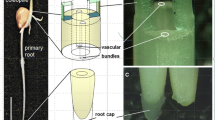Abstract
The kinetics of gravitropism and of amyloplast sedimentation were studied in dark-grown protonemata of the moss Ceratodon purpureus (Hedw.) Brid. The protonemata grew straight up at a rate of 20–25 μm·h− in nutrient-supplemented agar. After they were oriented to the horizontal, upward curvature was first detected after 1–1.5 h and reached 84° by 24 h. The tip cells exhibited an amyloplast zonation, with a tip cluster of nonsedimenting amyloplasts, an amyloplast-free zone, and a zone with pronounced amyloplast sedimentation. This latter zone appears specialized more for lateral than for axial sedimentation since amyloplasts sediment to the lower wall in horizontal protonemata but do not fall to the basal wall in vertical protonemata. Amyloplast sedimentation started within 15 min of gravistimulation; this is within the 12–17-min presentation time. The data support the hypothesis that some amyloplasts function as statoliths in these cells.
Similar content being viewed by others
References
Banbury, G.H. (1962) Geotropism of lower plants. In: Encyclopedia of plant physiology, vol. 17, part 2: Physiologie der Bewegungen, pp 344–377, Ruhland, W., ed. Springer, Berlin Göttingen Heidelberg
DeMaggio, A.E., Steuer, D.A. (1977) Protonemal organization and growth in the moss Dawsonia superba: ultrastructural characteristics. Am. J. Bot. 64, 449–454
Hartmann, E., Klingenberg, B., Bauer, L. (1983) Phytochrome mediated phototropism in protonemata of the moss Ceratodon purpureus Brid. Phytochem. Photobiol. 38, 599–603
Jenkins, G.I. Courtrice, R.M., Cove, D.J. (1986) Gravitropic responses of wild-type and mutant strains of the moss Physcomitrella patens. Plant Cell Environ. 9, 637–644
Jensen, L.C., Jensen, C.G. (1984) Fine structure of protonemal apical cells of the moss Physcomitrella turbinatum. Protoplasma 122, 1–10
Kiss, J.Z., Sack, F.D. (1989) Reduced gravitropic sensitivity in roots of a starch-deficient mutant of Nicotiana sylvestris. Planta 180, 123–130
Kiss, J.Z., Hertel, R., Sack, F.D. (1989) Amyloplasts are necessary for full gravitropic sensitivity in roots of Arabidopsis thaliana. Planta 177, 198–206
Petschow, F. (1933) Geotropismus und Statolithenstärke bei Bryophyten. Beih. Bot. Zbl. 51, 287–310
Sack, F.D., Kiss, J.Z. (1989) Plastids and gravity perception. In: Physiology, biochemistry, and genetics of non-green plastids, in press, Shannon, J., Boyer, C., eds. American Society of Plant Physiologists, Rockville, Md.
Schmiedel, G., Schnepf, E. (1979) Side branch formation and orientation in the caulonema of the moss, Funaria hygrometrica: normal development and fine structure. Protoplasma 100, 367–383
Schwuchow, J., Sack, F.D., Hartmann, E. (1989) Gravity affects the distribution of microtubules in gravitropic protonema of the moss Ceratodon. (Abstr.) Plant Physiol. 89, Suppl., 93
Sievers, A., Volkmann, D. (1979) Gravitropism in single cells. In: Encyclopedia of plant physiology, N.S., vol. 7: Physiology of movements, pp. 567–572, Haupt, W., Feinleib, M.B., eds. Springer, Berlin Heidelberg New York
Tewinkel, M., Volkmann, D. (1987) Observations of dividing plastids in the protonema of the moss Funaria hygrometrica Sibth. Planta 172, 309–320
Volkmann, D., Sievers, A. (1979) Graviperception in multicellular organs. In: Encyclopedia of plant physiology, N.S., vol. 7: Physiology of movements, pp. 573–600, Haupt, W., Feinleib, M.E., eds. Springer, Berlin Heidelberg New York
Walker, L., Sack, F. (1989) Recovery of gravitropism after centrifugation correlates with amyloplast sedimentation. Bull. Am. Soc. Gravit. Space Biol. 3, 125
Young, J.C., Sack, F.D. (1989) Videomicroscopy-based observation of gravitropism in individual protonema of the moss Ceratodon. Bull. Am. Soc. Gravit. Space Biol. 2, 61
Author information
Authors and Affiliations
Additional information
This work was supported by the National Aeronautics and Space Administration grant NAGW-780. We thank Professor E. Hartmann and J. Schwuchow for providing Ceratodon cultures, Dr. John Z. Kiss and Jeff Young for valuable discussions, and Professor Rainer Hertel (University of Freiburg, FRG) for bringing this material to our attention.
Rights and permissions
About this article
Cite this article
Walker, L.M., Sack, F.D. Amyloplasts as possible statoliths in gravitropic protonemata of the moss Ceratodon purpureus . Planta 181, 71–77 (1990). https://doi.org/10.1007/BF00202326
Received:
Accepted:
Issue Date:
DOI: https://doi.org/10.1007/BF00202326




